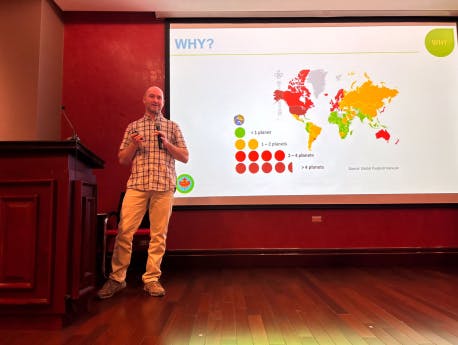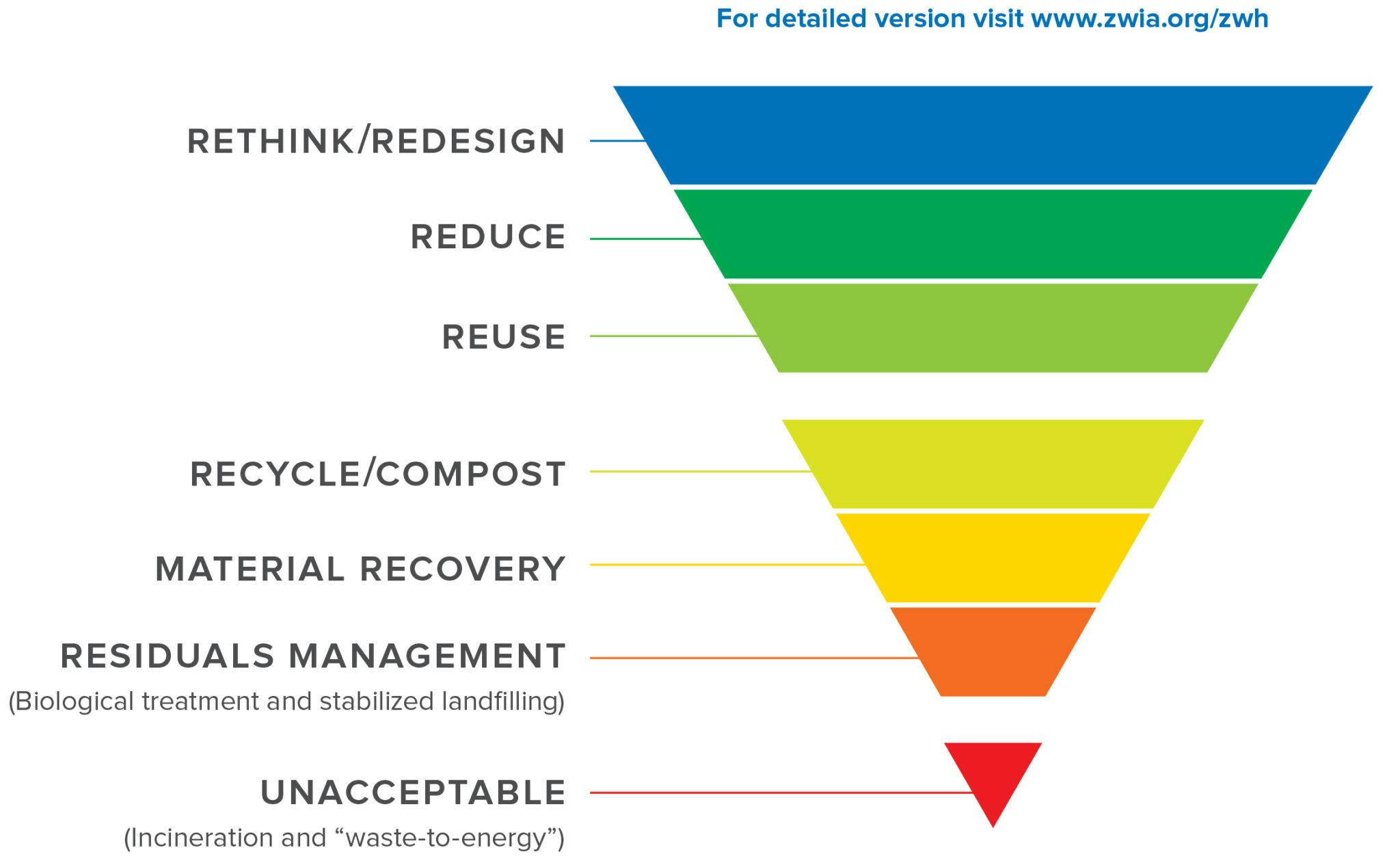
the international zero waste definition
Zero Waste Hierarchy of Highest and Best Use 8.0

Purpose
The Zero Waste Hierarchy describes a progression of policies and strategies to support the Zero Waste system, from highest and best to lowest use of materials. It is designed to be applicable to all audiences, from policy-makers to industry and the individual. It aims to provide more depth to the internationally recognized 3Rs (Reduce, Reuse, Recycle); to encourage policy, activity and investment at the top of the hierarchy; and to provide a guide for those who wish to develop systems or products that move us closer to Zero Waste. It enhances the Zero Waste definition by providing guidance for planning and a way to evaluate proposed solutions. Users are encouraged to develop policies and actions starting at the top of the hierarchy.

Zero Waste Definition
Zero Waste: The Conservation of all resources by means of responsible production, consumption, reuse, and recovery of all products, packaging, and materials without burning them and with no discharges to land, water, or air that threaten the environment or human health.
Guiding Principles
Closed Loop Systems
Design systems to be closed loop rather than linear in their use of resources
Close to Source
Processes to occur as close to the source as practical
Conservation of Energy
More energy can be saved, and global warming impacts decreased, by reducing waste, reusing products, recycling and composting than can be produced from burning discards or recovering landfill gases.
Do Not Export Harm
Avoid the export of toxic or potentially toxic waste or materials, as well as materials with limited or undefined recycling markets that will be landfilled or incinerated in other regions.
Engage the Community
Promote changes and systems that work with communities to facilitate meaningful and sustained participation, increase understanding, and influence behaviour change and perceptions.
Highest and Best Use
Creating and keeping materials and products for a use as high on the hierarchy as possible and in the useful loop as long as possible. Keeping materials from being downcycled where the number of future uses or options are limited. Source separate items and materials to the extent necessary to ensure clean and marketable products and materials for reuse, recycling and composting streams.
Information & Improvement
Collect information on systems and use as feedback for continuous improvement.
Local Economies
Support the growth and expansion of local economies (production, repair, and processing) in order to reduce greenhouse gases from transportation, improve accountability and resiliency, and increase repair and parts opportunities.
Materials Are Resources
Preserve materials for continued use and use existing materials before harvesting virgin natural resources.
Minimize Discharges
Minimize all discharges to land, water or air that threaten the environment, or human health, including climate changing gases
Opportunity Costs
Consider opportunity costs of investments and ensure investments occur as high as possible on the Hierarchy.
Precautionary Principle
Ensure that a substance or activity which poses a threat to the environment is prevented from adversely affecting the environment, even if there is no conclusive scientific proof linking that particular substance or activity to environmental damage .
Polluter Pays
Whoever causes environmental degradation or resource depletion should bear the “full cost” to encourage industries to internalize environmental cost and reflect them in the prices of the products
Sustainable Systems
Develop systems to be adaptable, flexible, scalable, resilient, and appropriate to local and global ecosystem limits
Zero Waste Hierarchy 8.0
RETHINK / REDESIGN
Systemic change to move towards a closed loop** model; redesign of systems to avoid needless and/or wasteful consumption. Actions that address the root causes of the current linear use of materials.
1. Consider if a purchase is necessary and reject unnecessary, unsolicited items
2. Design and purchase products from reused, recycled or sustainably-harvested renewable, non-toxic materials to be durable, repairable, reusable, fully recyclable or compostable, and easily disassembled
3. Shift funds and financial incentives to support a Circular Economy** over the harvesting and use of virgin natural resources
4. Enact new incentives for cyclical use of materials, and disincentives for wasting
5. Facilitate change in how end users’ needs are met from “ownership” of goods to “shared” goods and provision of services
6. Support and expand systems where product manufacturing considers the full life-cycle of their product in a way that follows the Zero Waste Hierarchy and moves towards more sustainable products and processes. Producers take back their products and packaging in a system that follows the Zero Waste Hierarchy
7. Identify and phase out materials that cause problems for Closed Loop Systems*
8. Facilitate and implement policies and systems to encourage and support Local Economies*
9. Re-consider purchasing needs and look for alternatives to product ownership
10. Provide information to allow for informed decision-making
11. Eliminate or avoid systems that drive needless consumption
REDUCE
Measures taken to reduce the quantity and toxicity of resources, products, packaging and materials as well as the adverse impacts on the environment and human health (while reduction is noted here it is acknowledged that people’s basic needs should be met; not everybody needs to reduce).
12. Plan consumption and purchase of perishables to eliminate or avoid discards due to spoilage and non-consumption
13. Implement Sustainable Purchasing** that supports social and environmental objectives as well as local markets.
14. Minimize quantity and toxicity of materials used.
15. Minimize ecological footprint required for product, product use, and service provision.
16. Choose products that maximize the usable lifespan and opportunities for continuous reuse.
17. Choose products that are made from materials that are easily and continuously recycled.
18. Prioritize the use of edible food for people.
19. Prioritize the use of edible food for animals.
REUSE
Actions by which products or components are used again for the same or similar purpose for which they were conceived. Actions that support the continued use of products in ways that retain the value, usefulness and function.
20. Maximize reuse of materials and products.
21. Maintain, repair or refurbish to retain Value**, usefulness and function.
22. Remanufacture with disassembled parts; dismantle and conserve “spare” parts for repairing and maintaining products still in use.
23. Repurpose products for alternative uses.
RECYCLE/COMPOST
Actions by which discards are mechanically reprocessed into products or materials or biologically processed to return to the soil.
24. Support and expand systems to keep materials in their original product loop and to protect the full usefulness of the materials
25. Maintain diversion systems that allow for the highest and best use of materials, including organics
26. Recycle and use materials for as high a purpose as possible
27. Develop resilient local markets and uses for collected materials wherever possible
28. Provide incentives to create clean flows of compost and recycling feedstock
29. Support and expand composting as close to the generator as possible (prioritizing home, on site or local composting)
30. Consider industrial composting whenever home/decentralized composting is not possible, or if local conditions require/allow anaerobic digestion
MATERIAL RECOVERY
Any operation to salvage additional materials after the actions above. Does not include energy recovery and the reprocessing into materials that are to be used as fuels or other means to generate energy, which are unacceptable practices.
31. Maximize materials recovery from mixed discards after extensive source separation
32. Consider chemical processing for recycling** in the form of repolymerization (i.e. Plastic-to-Plastic or P2P) only for materials which are not suitable for mechanical recycling
33. Backfilling**
RESIDUALS MANAGEMENT
Handling of discards that were wasted in a way that does not threaten the environment or human health. Analyze what was wasted and why.
34. Examine materials that remain and use this information to refine the systems to rethink, reduce, reuse, and recycle in order to prevent further discards.
35. Ensure minimization of impacts by means of biological stabilization of fermentable materials. Recover energy using only systems that operate at Biological Temperature and Pressure**.
36. Encourage the preservation of resources and discourage their dispersal and Destructive Disposal**
37. Plan systems and infrastructure to be adjusted as discards are reduced and its composition changes.
38. Minimize Gas Production and Release** and maximize gas collection.
39. Use existing landfill capacity and maximize its lifespan. Ensure it is Responsibly Managed. **
40. Contain and control, for responsible management, discards that threaten the environment or human health.
UNACCEPTABLE
Systems and policies which encourage wasting or threaten the environment and human health.
41. Don't allow policies and systems that encourage the Destructive Disposal and/or the destruction of discards
42. Don't allow energy and Destructive Disposal systems that are dependent upon the continued production of discards
43. Don't allow the Incineration** of discards
44. Don't allow discards to be used in products or materials that risk or cause adverse environmental or human health impacts.
45. Don't allow chemical processing of discards into fuel** (i.e., Chemical Processing of Plastics to Fuel)
46. Don't allow the use of discards in cement kilns
** Definitions
Biological Temperature and Pressure
The ambient temperature and pressure that occurs naturally without the use of added energy, or in any case not above 100 degrees Celsius or 212 degrees Fahrenheit.1
Backfilling
Any operation where suitable non-hazardous, non-contaminated inert material such as stone, soil, clay, sand, brick, porcelain, ceramic, or glass is used for purposes of reclamation in excavated areas or for engineering purposes. Discards used for backfilling must be suitable for the aforementioned purposes, and be limited to the amount strictly necessary to achieve those purposes.
Circular Economy
An industrial economy that is, by design or intention, restorative and in which material flows are of two types, biological nutrients, designed to re-enter the biosphere safely, and technical nutrients, which are designed to circulate at high quality without entering the biosphere. Materials are consistently reused rather than wasted. All options that cause leakage or losses of material from their circular management (such as incineration, co-incineration, fuel production, fuel use, and the like) are not part of a Circular Economy system. Circular economy should be clearly defined to follow the Zero Waste Hierarchy and not show energy recovery as a process prior to landfilling.
Chemical Processing for Recycling
Processing of carbon-based materials such as plastics repolymerization (Plastic-to-Plastic or P2P). I.e., recovery as new polymers not intended for fuels. This may include solvolysis, solvent-based purification, and the like. Recovery of material for recycling must be over 90%.
Chemical Processing for Fuel
Any type of process {for example , Plastics to Fuel (P2F), that converts – typically through thermal cracking – most of the carbon included in plastics, into a syngas and/or other fuel. It may also be inappropriately described as “chemical recycling” or “advanced recycling”.
Closed Loop System
A system not relying on matter exchange outside of the system, as opposed to open loop where material may flow in and out of the system.
Destructive Disposal
Discarded materials placed in a landfill or in an Incineration** facility.
Discards
Materials that are disposed of because they are no longer useful or desirable to their current owner. This includes but is not limited to materials sent for reuse, composting, recycling, landfilling, or incineration.
Incineration
Incineration is a form of Destructive Disposal via combustion or thermal conversion/treatment of discarded materials into ash/slag, syngas, flue gas, fuel, or heat. Incineration includes facilities and processes that may be stationary or mobile, may recover energy from heat or power and may use single or multiple stages. Some forms of incineration may be described as resource recovery, energy recovery, trash to steam, waste to energy, energy from waste, fluidized bed, catalytic cracking, biomass, steam electric power plant (burning waste), pyrolysis, thermolysis, gasification, plasma arc, thermal depolymerization, refuse derived fuel, or chemical processing of plastics to fuel.
Minimize Gas Production and Release
Keeping out source-separated organics and biologically stabilizing the materials that go into landfill. For existing landfill cells that already contain unstabilized organics, the gas production should be minimized by keeping out rainwater and not recirculating leachate. Minimize methane release by permanently capping closed cells with permanent covers and installing gas collection systems within months of closure (not years). Maintain high suction on collection wells and do not damp down wells or rotate off the wells to stimulate methane production. Filter toxins in the gas into a solid medium that is containerized and stored on site. Note that this is not considered a renewable energy.
Problematic for a Closed Loop System
Materials that make it hard to recycle or compost the materials themselves or other materials. These may be contaminants for a material (like some forms of biodegradable plastics or stickers on fruit and vegetables) or materials that clog processing systems (like plastic bags).
Responsibly Managed Landfills
Manage landfills to minimize discharges to land, water or ai
Sustainable Purchasing
The purchase of goods and services that take into account the economic value (price, quality, availability and functionality) and the related environmental and social impacts of those goods and services at local, regional, and global levels.
Value
The importance, worth, or usefulness of something that may be economic, social, environmental, cultural, or sentimental.
1. Unless higher temperatures are required as a pretreatment, not to exceed 150 degrees Celsius (e.g., to control diseases, or reduce pathogens) to be then subject to composting or Anerobic Digestion; the pretreatment should never be used to destroy materials.